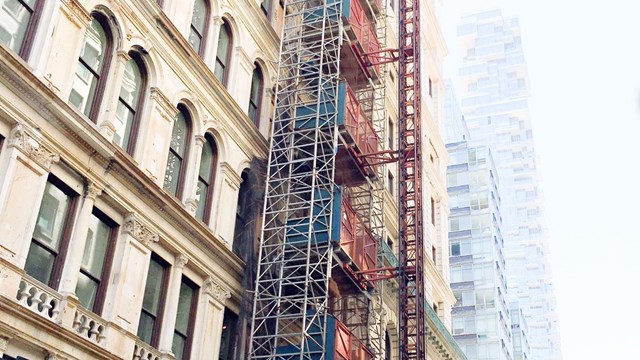Picture this: The power goes out in Washington Heights. When it comes back on in Washington Heights, it goes out in Clinton. When it comes back on in Clinton, it goes out in Battery Park City. And so on, across the city. Panic sets in, chaos reigns, and the super doesn’t get your message because his answering machine is plugged into a useless socket on the wall.
This is a rolling blackout, an extreme measure already used by California this past winter to conserve energy. New York City is unlikely to resort to rolling blackouts this summer, but make no mistake: The city does face a potential energy shortage. In a recent press release, Carol Murphy, executive director of the New York Independent System Operator (NYISO) put it plainly: "We’re definitely concerned about [rolling blackouts] in the downstate and New York City area. If we have a cool summer, we could be fine, but if it’s a bad summer, we’re really in trouble." With temperatures in Midtown Manhattan slowly creeping into the low 90s, the ISO’s warnings could come true before the first cold snap of autumn.
Static Electricity Production
To illustrate the potential energy shortages facing New York residents, it is instructive to examine the circumstances that led to California’s current woes. In 1996, California’s state legislature passed a complicated bill partially "restructuring" its utilities. Pacific Gas & Electric (PG&E) and other large power companies had to divest the bulk of their electricity-generating holdings but were prohibited from signing stable, long-term contracts with buyers. The companies became, in effect, liaisons between the power plants and their customers.
California deregulated the wholesale price of electricity while freezing retail rates at low levels. In other words, the amount PG&E charged customers was controlled, but the amount the company paid for the power was not. As demand for energy reached a fever pitch with the dot-com explosion of the mid-’90s, the plants charged more and more money for their power, but PG&E and similar companies were not allowed to increase their rates. Eventually, the companies simply ran out of money, exacerbating an already troubled energy market.
Like California, New York passed a bill deregulating utilities in the late ‘90s. The energy crisis facing New York City is largely a matter of simple economics. Population-and therefore demand for energy-has increased, while the power supply has remained static. The set of variables at work here have led both energy experts and politicians to foretell doom, while others warn against alarmist rhetoric that fosters undue anxiety and produces few real results. Senator Charles Schumer (D, NY) said in a press conference last October, "Because of New York’s unique geography and our ever-increasing use of electricity, oil, and gas, we remain the most vulnerable region in the country to an energy crisis," while George Drosdowich, director of client relations at Utilisave, the New York-based energy cost auditing company, says, "The rate of growth in New York State has not increased to overcome generating capacity. It’s not the same as California."
The reality of the situation is that, unlike the rest of New York, which can import electrical power from other sources, New York City has a limited number of connections to upstate power grids. This means most of the city’s power must be self-generated. In its report to the press, the ISO stressed the need for upgrading the entire state’s power infrastructure-not just that of New York City-and reiterated that urban New York could face "a very serious situation" in the near future unless steps are taken immediately to conserve and produce new energy.
In concrete terms, a single megawatt of power is enough to run about 350 apartments during periods of peak demand. Utility giant Con Edison anticipates New York City will use 10,500 megawatts of power this summer. The company has 8,000 megawatts in store and can generate 700 more megawatts. An additional 5,000 megawatts can be imported through the power lines, for a total of almost 14,000-four thousand more than was forecast. With the excess imported power, blackouts are unlikely this summer.
"I don’t believe there is a crisis," Drosdowich says. He would know; he was director of energy in Yonkers during the crisis-filled 1970s.
Another guardedly optimistic expert is Greg Wortham, vice president and chief operating officer at 1st Rochdale Cooperative, an electric utility serving co-ops and condos in the New York City area. According to Wortham, it would take a confluence of factors to bring Gotham’s power grid to its knees-something more than a few hot days, or a single plant outage. "It’s not an issue of any one thing going out," says Wortham. "If we had two or three consecutive weekdays of 100-degree temperatures, combined with a transport line interruption or a plant outage, then we’d see problems. As of now, if the transport lines hold, and the plants stay online, it can be a hot summer without us seeing any major problems."
The Mayor, however, disagrees. "This year," says Rudy Giuliani, "without new generation, the city will not have enough power [to supply the demand]."
Whatever happens this summer, there are not enough power plants to generate the energy needed to power the city for the long haul, and that could spell disaster this winter and in the years ahead. According to Wortham, next summer New Yorkers can expect to see "more aggressive energy-efficiency programs–short of making people sweat in their apartments." Wortham’s company advocates new, more energy-efficient appliances to replace older models that do less work with three or four times the energy consumption. In the very long term, Wortham–like the Mayor and others in the utility industry–acknowledges the necessity for new means of generating energy and transporting it to where it’s needed most.
Power Plants and the Environment
On the supply side of the issue, there are currently seven proposals to build new power plants around the city, pending Mayor Giuliani’s consideration. The question is, where will these seven as-yet-hypothetical power plants be put? Obviously, no one wants a power plant in her backyard. Historically, power plants drive property values down and degrade air quality.
A proposal to build a power plant in Greenpoint, Brooklyn (already home to one of the largest sewage treatment plants in the city) was withdrawn last year amidst loud resident protest. Human rights groups take issue with proposals that aim to put plants in poor neighborhoods with significant minority populations. Most of the proposals currently on the table propose to do just that. Environmentalists too rail against many proposals, arguing that power plants almost always negatively impact the surrounding environment and pollute air already laden with contaminants from the city itself.
These opposition groups have Albany on their side. According to state regulations, groups opposing the plants-like the neighborhood coalition in Greenpoint-can demand compensatory financing from the very companies who want to build the plants, to the tune of $1,000 per proposed megawatt.
To build another Ravenswood (the city’s largest plant, in Long Island City), a corporation would have to dole out over $2 million to its opponents, with no guarantee of a return on the investment. On top of that, power plants cannot be built just anywhere. They have to be close to subsystems, natural gas lines and a water source for cooling.
"The City will do its best to help mitigate the consequences of these plants on the affected communities," the Mayor says, "but we can’t change these realities."
Deregulations and Rate Freezes
Despite arguments to the contrary, deregulation is not to blame for California’s energy woes. The state’s agonies have more to do with price freezes and bad management than with privatization. Pennsylvania deregulated its utilities years ago, and still has some of the lowest rates and highest customer satisfaction ratings in the country. For his part, Drosdowich believes the "artificially generated" and manipulated energy market is to blame for New York’s current problems.
New York does not utilize rate freezes. If there is an emergency here–if a heatwave in mid-August is compounded by a major service interruption at a power plant, say-that threatens to necessitate California-style rolling blackouts, mounting utility bills will (theoretically) raise awareness of the problem among the voting public, who will put further pressure on politicians to solve the problem.
In contrast to the arrangement in New York, California consumers read about the crippling energy crisis, but because of the retail rate freeze, did not see the bad times reflected in their monthly bill. Thus, they used even more power than before, not recognizing the looming crisis before it was too late.
Mayor Giuliani has said, "The 43 percent increase that New Yorkers had to pay last summer was unacceptable," and that transitional price controls on the wholesale market–the opposite of what California did–will protect customers from price spikes until the market is fully deregulated.
Drosdowich, on the other hand, opposes tinkering with the market. "Vigilance and enforcement–real enforcement–of the existing rules should be adequate. Price caps should be used if there is an emergency," he adds, "But there isn’t one."
After the blackout two summers ago in Washington Heights, Mayor Giuliani formed the Task Force on Electric Reliability. New York has had no blackouts since, and if the Mayor has his way, there won’t be another on his watch.
"A situation like that of California," he told the New York City Partnership, "where the regular possibility of blackouts is high, is unacceptable in New York."
If the worst happens and your home is blacked out, turn off all electronic equipment and appliances except one light bulb. This will avoid a power surge when the juice is turned back on. Rolling blackouts typically last an hour and do not affect hospitals, fire departments or police stations.
A National Problem
Immediate concerns aside, the energy shortages in California and New York are harbingers of a nationwide energy crisis.
Demand for energy, particularly for natural gas and electricity, is on the rise. The supply of energy is regulated by state statutes that often don’t keep pace with technology. These regulations perpetuate a volatile political environment and discourage investment in research. An outmoded infrastructure further exacerbates the situation. For example, as a stopgap measure in New York, one company proposed to renovate the Astoria Generating 2 plant, a monument to air pollution and inefficiency that was shut down in 1993 for a score of environmental and regulatory reasons.
As U.S. Energy Secretary Spencer Abraham remarked in a recent address to the US Chamber of Commerce, "The good news is that America’s energy problems can be solved. The bad news is that the situation in California is not isolated, it is not temporary, and it will not fix itself."
If New York does not address its precarious energy situation with the proper urgency, by next year you may be reading your
Mr. Olear is a freelance writer and editor of a weekly Web magazine.







Leave a Comment